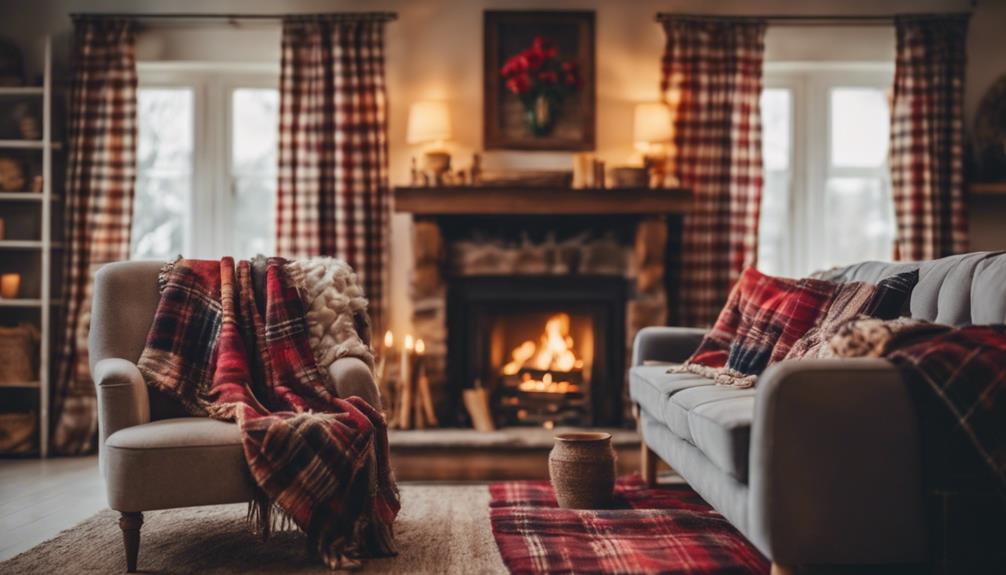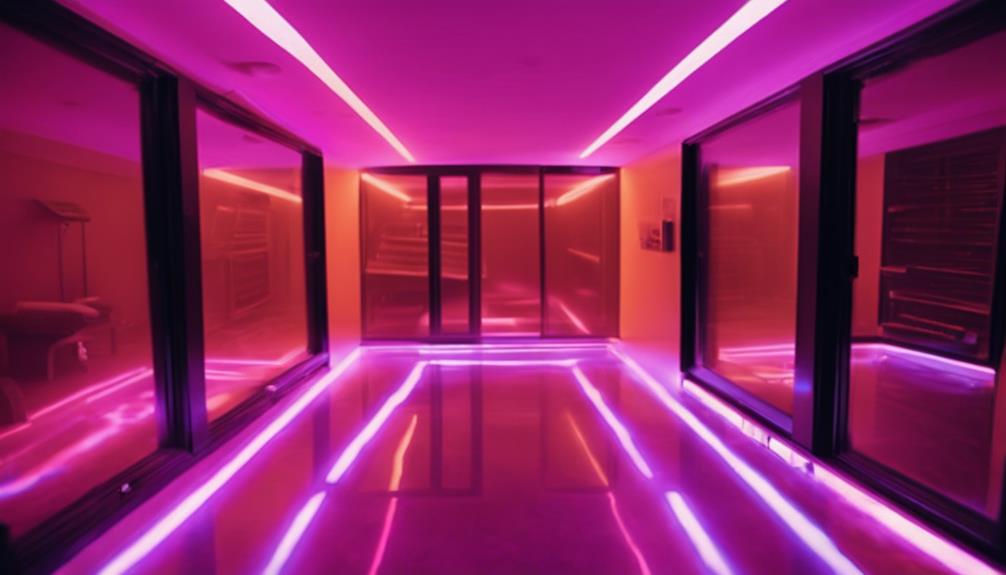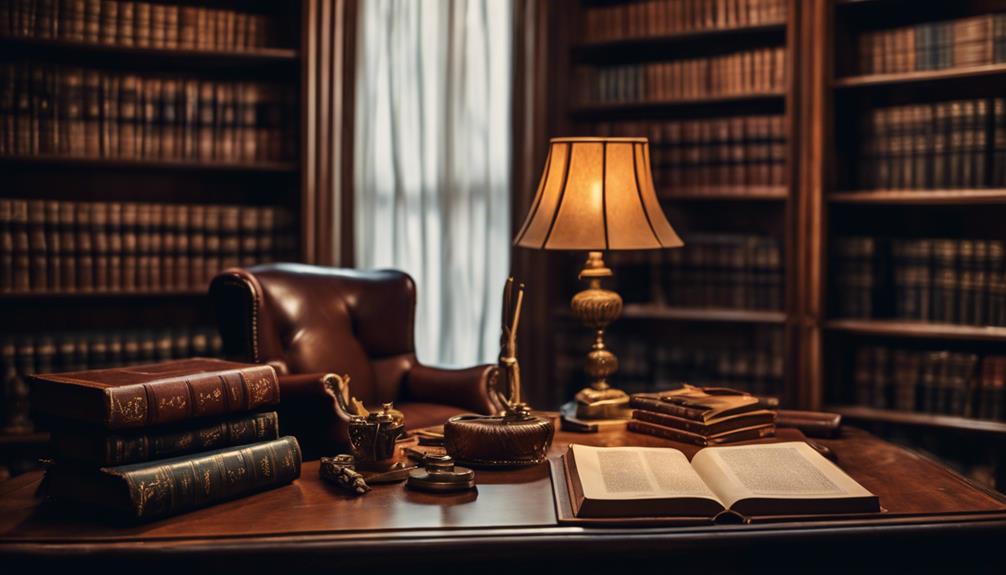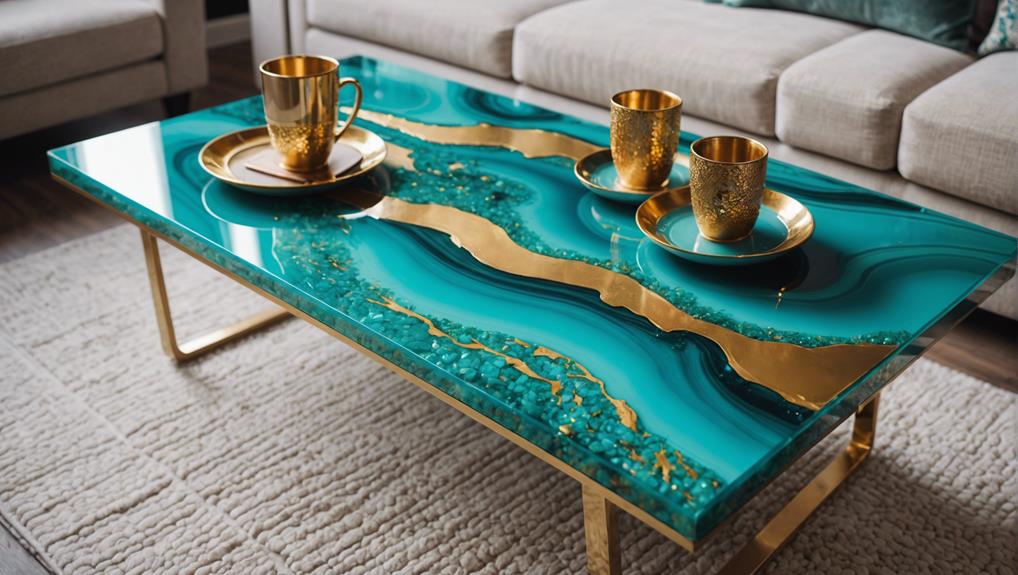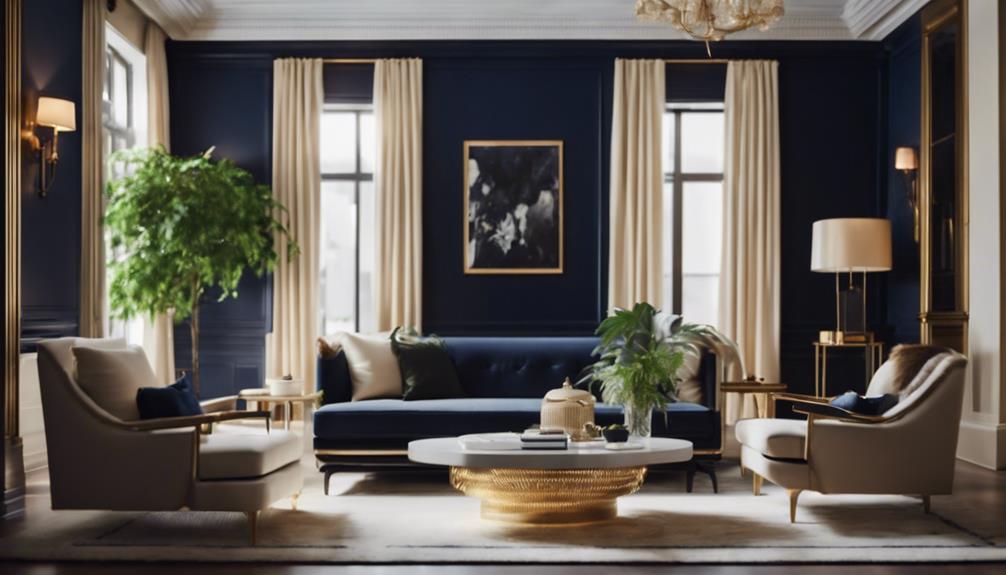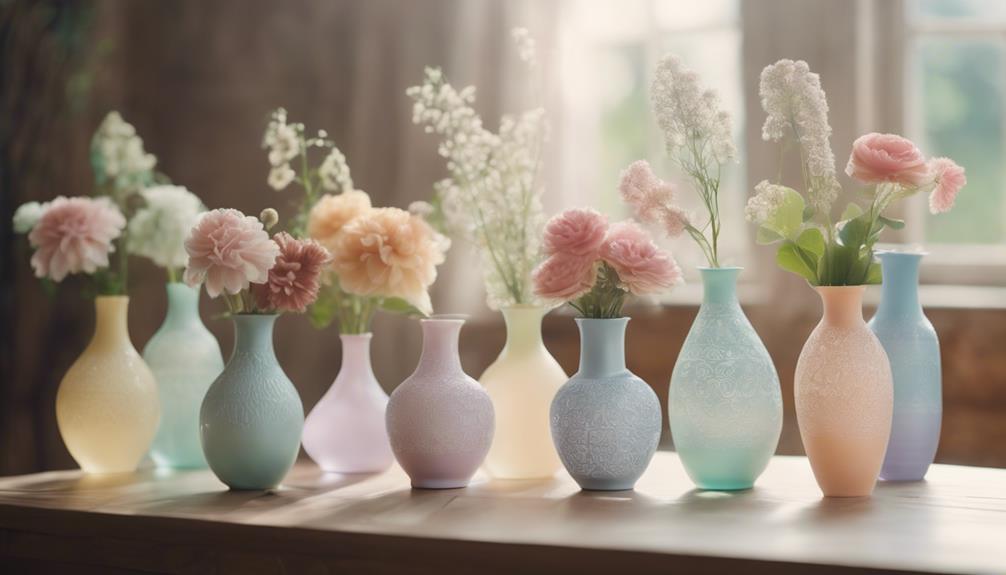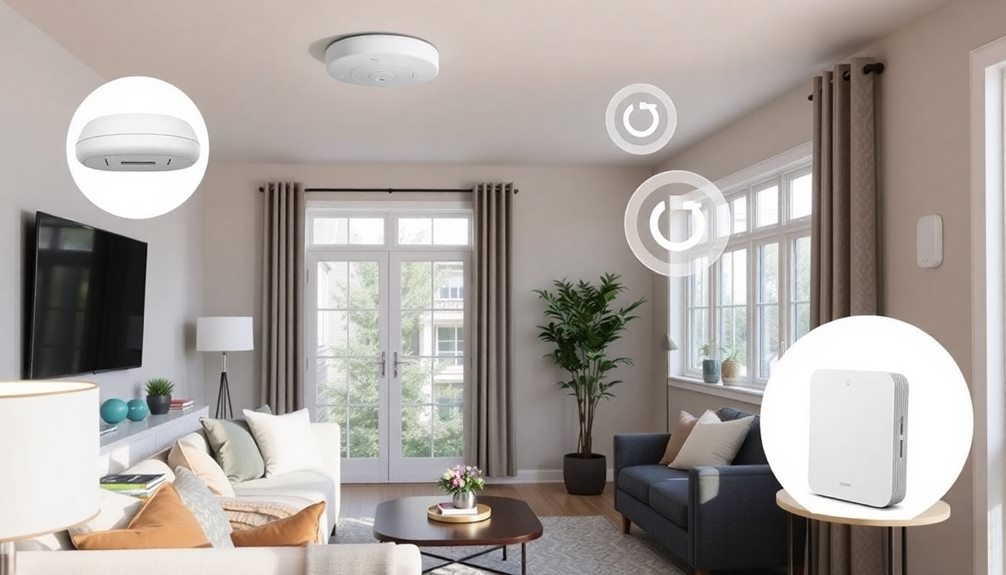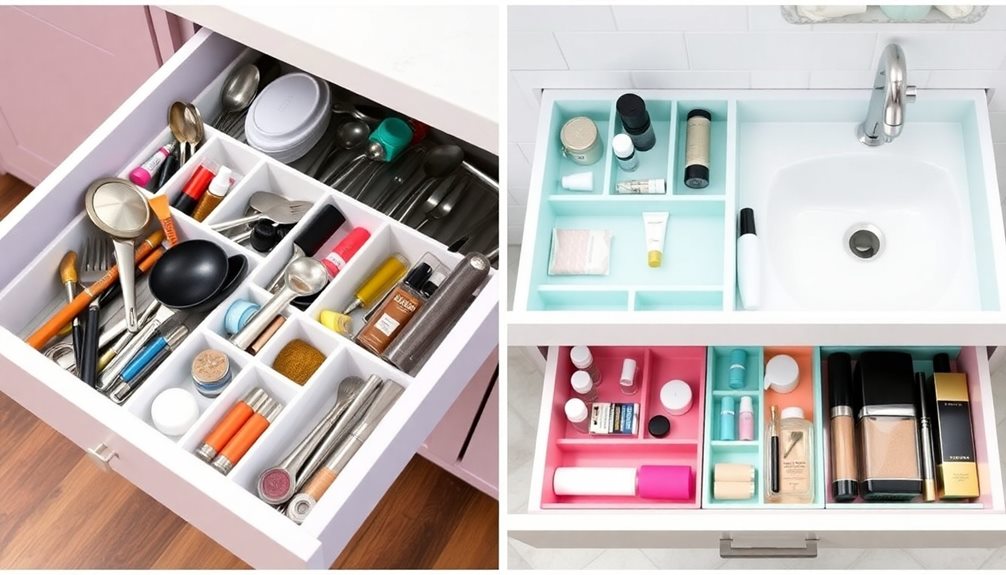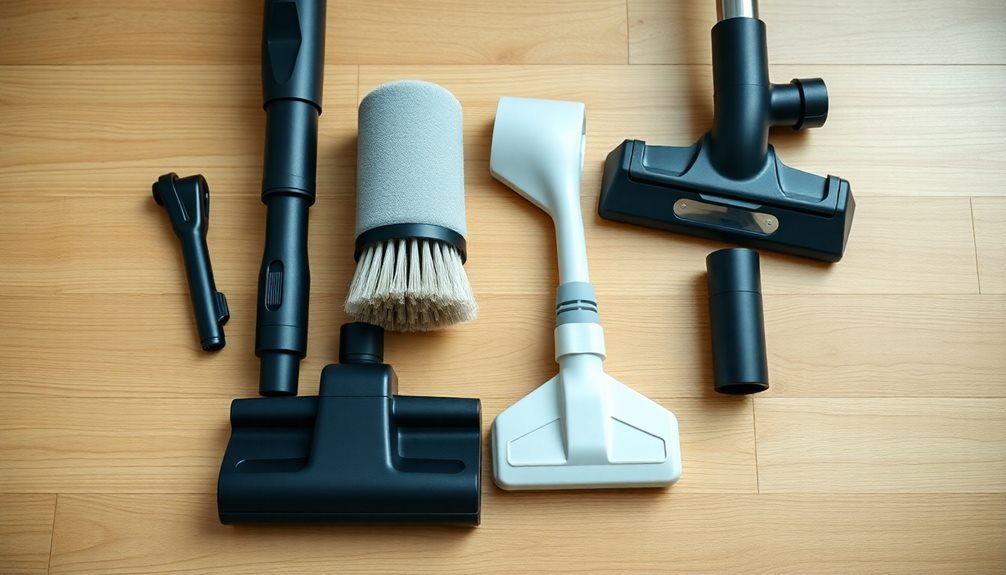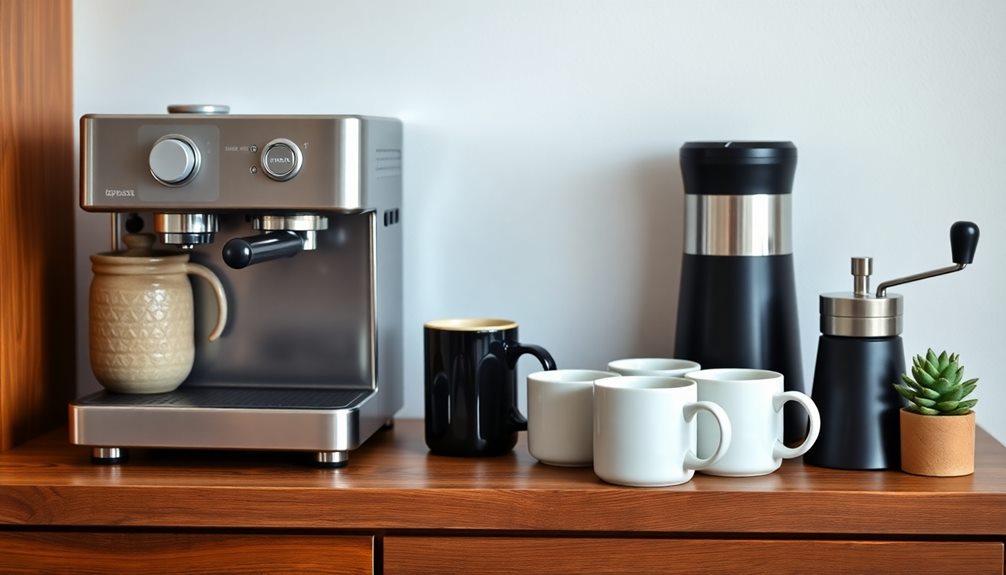When deciding between floral and plaid for your country living room, consider the vibe you want to create. Floral patterns add warmth and vibrancy, making your space feel cheerful and inviting. On the other hand, plaid offers a more muted, rustic charm with grounded aesthetics. You can mix textures, using soft floral materials alongside sturdy plaid fabrics for balance. Don't forget to incorporate unique lighting and decorative elements like vintage items to enhance the overall feel. The choice really depends on your personal style and the atmosphere you wish to achieve in your home. Explore your options for a perfect blend!
Key Elements
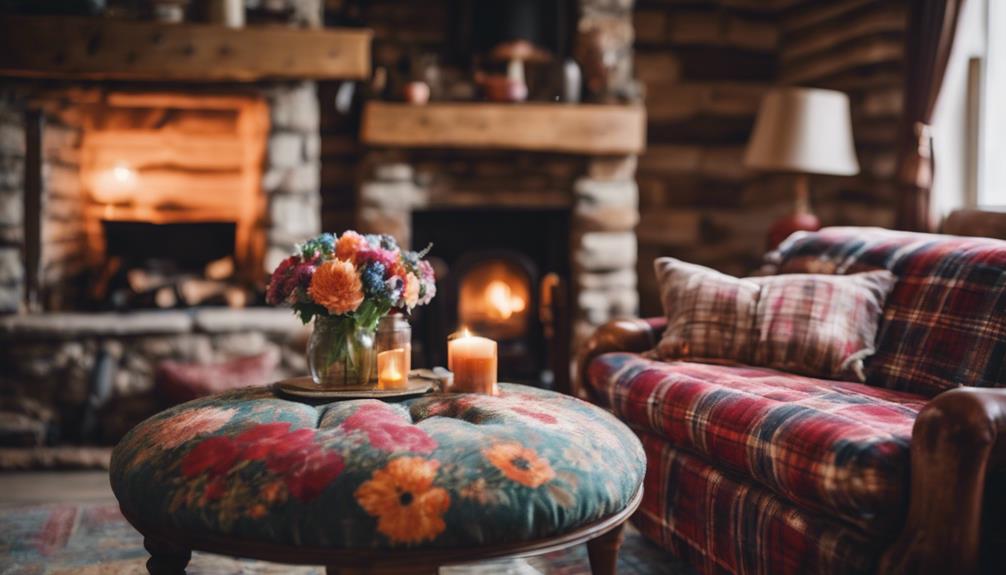
When choosing between floral and plaid for your country living room, consider the key elements of color scheme, materials, and textures.
Each pattern brings its own unique vibe to the space, so think about how they can harmonize with your existing decor.
Color Scheme
A well-chosen color scheme can seamlessly blend floral and plaid patterns, enhancing the cozy charm of your country living room. Floral patterns often bring a burst of warmth and vibrancy, creating a cheerful atmosphere. In contrast, plaid designs typically favor muted colors, lending a rustic feel that complements natural materials and earthy tones.
To achieve balance, consider incorporating warm neutrals and earthy colors, such as rich browns and muted greens. These shades not only ground the overall design but also allow floral accents to shine without overwhelming the space. For instance, a bright floral cushion can pop against a muted plaid sofa, creating visual interest while maintaining harmony.
When selecting a color scheme, make certain that the hues across both floral and plaid elements are cohesive. This approach fosters a seamless blend, preventing any clash between the lively florals and structured plaids.
Materials
Choosing the right materials is key to harmonizing floral and plaid patterns in your country living room, as each fabric type contributes to the overall aesthetic and comfort of the space.
Floral patterns often feature vibrant colors and intricate designs, typically crafted from soft materials like cotton or linen. These fabrics bring warmth and liveliness, making them perfect for soft furnishings like cushions and curtains.
On the other hand, plaid patterns provide a classic, cozy vibe, usually made from more durable materials such as wool or tweed. These fabrics add rustic charm and are ideal for heavier items like throws and upholstery, enhancing the traditional feel of your room.
When you consider wall treatments, floral wallpapers can create a cheerful backdrop, while plaid can lend a grounded, timeless look, especially in accent walls.
To achieve a balanced and inviting space, mix these materials thoughtfully. Use floral patterns to soften the boldness of plaid, ensuring that both styles complement each other.
Textures
To create a warm and inviting country living room, mixing a variety of textures—from soft cotton and wool to natural elements like wood and stone—plays an essential role in crafting a cozy atmosphere. Soft textiles like cotton or wool for upholstery not only provide comfort but also enhance the overall warmth of your space.
Incorporating natural materials, such as weathered wood and stone, contributes to the rustic charm that defines country living. You can achieve depth and visual interest by layering various textures, like chunky knit blankets paired with plaid pillows. This layering enhances the cozy atmosphere you're aiming for.
Vintage furniture pieces add unique textures and history to your decor, creating a personalized and inviting environment. Consider mixing finishes, like distressed metals alongside soft fabrics, to balance the rustic aesthetic while introducing a touch of modernity.
Essential Fixtures and Furniture
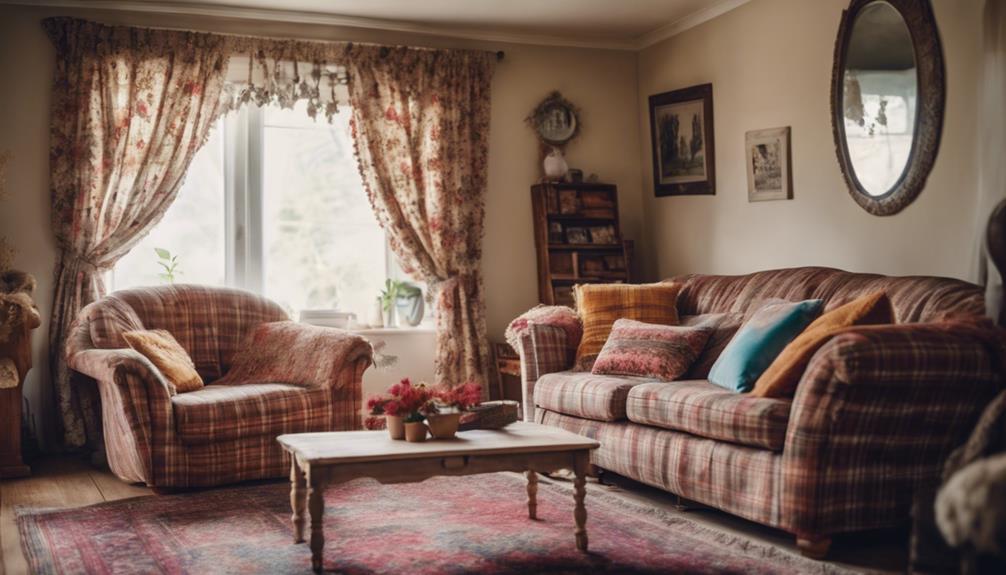
When it comes to essential fixtures and furniture for your country living room, you'll want to focus on key pieces that enhance the overall aesthetic.
A vintage farmhouse dining table, an antique sideboard with character, and a rustic farmhouse coffee table can create a warm and inviting atmosphere.
These elements not only complement floral or plaid designs but also reinforce the rustic charm you're aiming for.
Vintage Farmhouse Dining Table
A vintage farmhouse dining table adds a touch of rustic charm and durability to your country living room, making it an essential piece for both family meals and gatherings.
These tables often feature solid wood construction that emphasizes their durability while enhancing the rustic aesthetic of your space. With their distressed finishes, they not only provide a sense of history but also exude warmth, making your home feel cozy and inviting.
You'll find that vintage farmhouse tables come in various sizes, perfectly accommodating everything from intimate dinners to larger family gatherings. Their sturdy legs and unique design elements, like turned legs or trestle bases, enhance both functionality and style, ensuring they stand out in any country home.
Plus, incorporating a vintage farmhouse dining table into your decor allows you to mix and match with other traditional elements, such as mismatched chairs or colorful table settings, creating a welcoming atmosphere.
In essence, a vintage farmhouse dining table is more than just furniture; it's a centerpiece that brings people together, making it an indispensable addition to your country living room.
Antique Sideboard With Character
An antique sideboard often becomes the focal point of your country living room, offering both style and practical storage solutions. This piece of antique furniture can serve as a functional centerpiece, allowing you to store items while displaying vintage dishes or cherished family heirlooms. Its unique character often comes from distressed finishes and historical craftsmanship, which add a rustic touch that enhances the room's overall aesthetic.
Made from solid wood, many antique sideboards provide durability and a timeless appeal, perfectly complementing other natural materials in your decor. Selecting a sideboard with intricate carvings or distinctive hardware not only enhances the vintage style but also makes it a conversation starter for your guests.
Rustic Farmhouse Coffee Table
Building on the charm of an antique sideboard, a rustic farmhouse coffee table serves as a practical yet stylish centerpiece in your country living room. Typically crafted from reclaimed wood, these coffee tables emphasize sustainability while showcasing unique character in every piece. The distressed finish not only enhances the vintage aesthetic but also complements other elements within farmhouse interiors.
When choosing your coffee table, consider the size to guarantee it fits comfortably within your seating area. It should allow for easy access and flow, making your living space inviting. Many rustic farmhouse coffee tables come equipped with functional features like storage drawers or shelves, perfect for keeping your cozy area organized.
You can also personalize your choice with various styles, such as farmhouse chic or industrial farmhouse, allowing the coffee table to seamlessly blend with your overall decor. Whether you're enjoying a cup of coffee or entertaining guests, a rustic farmhouse coffee table provides both functionality and charm, making it an essential fixture in your country living room.
Lighting Ideas
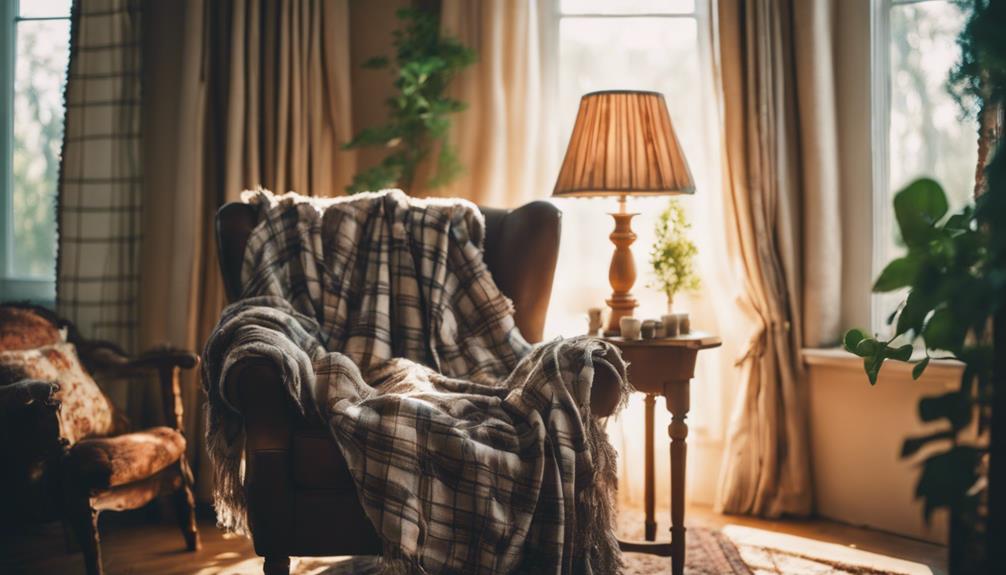
When it comes to lighting your country living room, think about incorporating rustic lanterns for that cozy ambiance.
Vintage Edison bulb fixtures and antique-style table lamps can add a touch of charm, while charming candle chandeliers create a warm glow for intimate gatherings.
Layering these elements will enhance the overall aesthetic and make your space feel inviting.
Rustic Lanterns for Ambient Lighting
Rustic lanterns create a warm, inviting glow that perfectly complements the natural materials and cozy decor of your country living room. These charming fixtures enhance ambient lighting by providing a soft radiance that makes your space feel welcoming and comfortable. You can find rustic lanterns in various styles, including wrought iron, wood, and glass, allowing you to choose options that resonate with your personal taste.
Hang them from ceilings to illuminate your room or place them on tables for added visual interest. Many rustic lanterns come equipped with flickering LED candles or traditional candle placements, giving you a safe yet authentic glow reminiscent of old-world charm. By incorporating these lanterns into your decor, you can create focal points that highlight architectural features like exposed beams or stone fireplaces.
Don't hesitate to mix sizes and styles of rustic lanterns; this adds depth and texture to your living room, helping create a layered and inviting atmosphere. With the right placement, rustic lanterns can transform your space into a cozy retreat, making it the perfect spot for relaxation and gatherings.
Vintage Edison Bulb Fixtures
Vintage Edison bulb fixtures effortlessly bring a nostalgic charm to your country living room, enhancing its inviting atmosphere with their warm glow and classic design.
These fixtures, featuring exposed filaments, emit a soft light that creates a cozy atmosphere perfect for relaxation or entertaining guests.
You'll find vintage Edison bulb fixtures in various styles, including pendant, chandelier, and wall sconces, making it easy to complement your space's rustic charm.
When strategically placed, they can serve as a focal point, drawing attention to your room's architectural features like exposed beams or rustic furnishings.
If you're looking for an eco-friendly option, consider energy-efficient LED Edison bulbs.
They maintain the vintage look while reducing energy consumption and extending bulb life, allowing you to enjoy the aesthetic without compromising on sustainability.
Incorporating these fixtures into your lighting design not only enhances the ambiance but also ties together diverse elements of your decor.
Whether you prefer a traditional or modern take on country style, vintage Edison bulb fixtures can elevate your living room, creating a warm and inviting space that reflects your personal taste.
Antique-style Table Lamps
While vintage Edison bulb fixtures set the mood, incorporating antique-style table lamps can further enhance the charm and sophistication of your country living room. These lamps often feature intricate designs and materials like brass, porcelain, or stained glass, adding a timeless elegance that complements rustic decor. Their unique shades, crafted from vintage fabrics or glass, can elevate the character of your space, offering decorating ideas that truly stand out.
Antique-style table lamps aren't just decorative; they provide both ambient and task lighting, helping to create a cozy atmosphere. Think about placing them on side tables or console tables to add warmth and functionality. When selecting the right lamps, pay attention to their height and scale in relation to your furniture to maintain a harmonious balance in your room.
Furthermore, these lamps showcase craftsmanship from different eras, making them conversation starters and focal points in your living room. By choosing antique-style table lamps, you'll not only illuminate your space but also infuse it with a touch of nature and history, enriching the overall ambiance of your country living room.
Charming Candle Chandeliers
Candle chandeliers can transform your country living room with their warm, inviting glow and charming designs that highlight natural materials and vintage decor. These fixtures are perfect for enhancing the rustic aesthetic of your space, providing a cozy ambiance that encourages gatherings and relaxation.
When you choose charming candle chandeliers, look for options featuring intricate designs, such as wrought iron or distressed wood. These elements add character and elegance, making your chandelier a stunning focal point. Opting for chandeliers that hold multiple candles guarantees your rustic living room is well-lit, creating an inviting atmosphere.
Consider varying the heights of your candle chandeliers to add visual interest and depth to your decor. This layering technique enhances the texture typical of country living rooms, making them feel more dynamic.
Decorative Elements
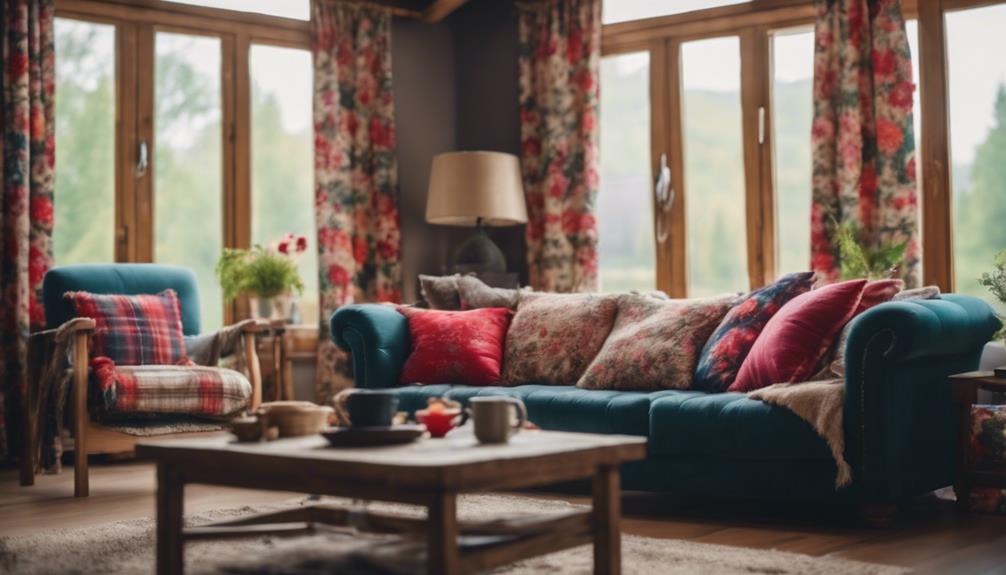
When it comes to decorative elements, think about incorporating handcrafted ceramic vases, vintage floral wall art, and woven wicker wall baskets.
These pieces not only enhance the country charm but also reflect your personal taste.
Handcrafted Ceramic Vase
How can handcrafted ceramic vases enhance the charm of your country living room? These unique decor pieces bring an artisanal charm that perfectly complements your rustic decor.
With their earthy glazes and textures, handcrafted ceramic vases introduce a natural feel that resonates with the warmth of your space.
You can use them as focal points by filling them with fresh flowers or dried arrangements, instantly adding color and life to the room. The beauty of these vases lies in their versatility; they come in various sizes, shapes, and colors, allowing you to create arrangements that reflect your individual style.
Incorporating handcrafted ceramic vases into your decor not only elevates the aesthetic but also adds a personal touch. Each piece showcases your appreciation for craftsmanship and supports local artisans, making your home feel more connected to the community.
Whether you opt for a single statement vase or a collection, these elements will enhance the overall ambiance of your country living room, making it a cozy retreat that tells your unique story.
Vintage Floral Wall Art
Vintage floral wall art adds a touch of nostalgia and warmth, making it a perfect focal point for your country living room. These art pieces often showcase intricate patterns and muted tones, which evoke tranquility and a connection to nature.
When you choose vintage floral wall art, you enhance the overall color palette of your space, allowing it to blend seamlessly with soft furnishings and wood accents. Incorporating these pieces into your decor not only complements rustic decor but also adds character and individuality to the room.
You can easily mix and match vintage floral art with other styles, like plaid or gingham, to create a layered and inviting aesthetic. This versatility allows you to express your personal style while maintaining a cozy atmosphere.
When selecting vintage floral wall art, consider how it reflects your tastes and the mood you want to create. By thoughtfully integrating these elements, you can transform your country living room into a warm, welcoming haven that feels uniquely yours.
Embrace the charm of vintage floral wall art, and let it breathe life into your decor!
Woven Wicker Wall Baskets
Woven wicker wall baskets bring a unique blend of texture and warmth to your country living room, instantly enhancing its cozy charm. These versatile decorative elements can serve dual purposes, acting as both storage solutions for items like magazines or throws and as stylish accents that complement rustic decor.
Available in various sizes and shapes, you can arrange woven wicker wall baskets in groupings to create an eye-catching focal point on a blank wall. This arrangement not only adds visual interest but also brings a sense of balance to the space. Incorporating natural materials like wicker helps connect your indoor area with nature, aligning perfectly with the essence of country living design principles.
Another advantage of woven wicker wall baskets is their adaptability. You can easily style them with seasonal decor, such as dried flowers or greenery, making them a dynamic addition to your living room decor.
Flooring
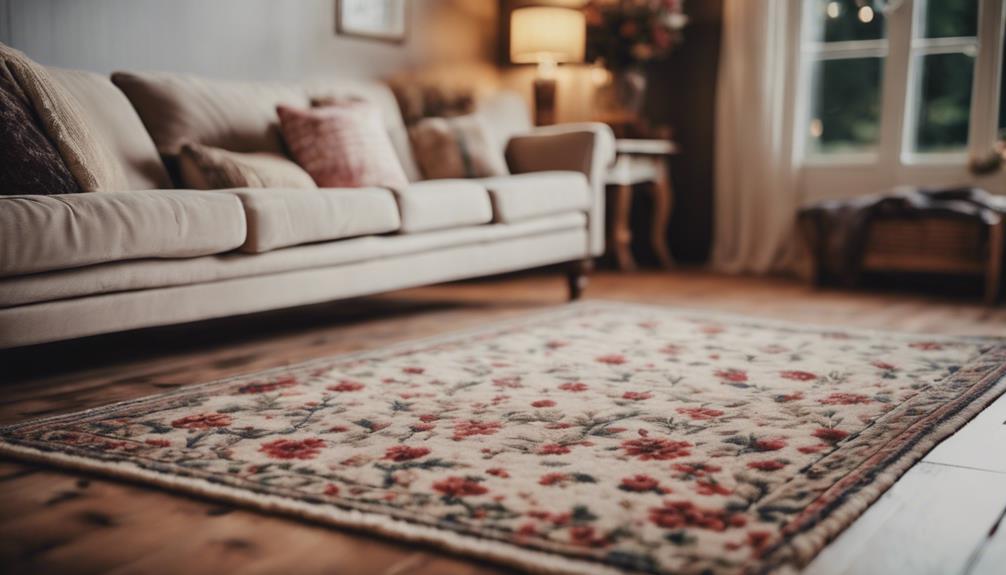
When it comes to flooring for your country living room, you can't go wrong with options like reclaimed barnwood plank or wide plank oak, both of which bring a rustic charm.
Hand-scraped maple hardwood offers a classic touch that pairs beautifully with floral and plaid patterns.
Choosing the right flooring will set the tone for your space, so consider your style carefully.
Reclaimed Barnwood Plank Flooring
Reclaimed barnwood plank flooring brings a unique blend of sustainability and rustic charm to your country living room, making it a standout choice for your home's aesthetic. This flooring option not only reduces waste but also infuses your space with character and history through its weathered wood appearance. Each plank showcases natural beauty with variations in color and texture, creating a cozy atmosphere that complements both floral and plaid design elements.
Choosing reclaimed barnwood means you're investing in durability. Its age and history often make it more resilient than new wood, ensuring it can withstand the everyday wear and tear of family life. Plus, the rustic vibe of reclaimed wood pairs beautifully with country living room decor, enhancing the overall warmth of your space.
Moreover, installing reclaimed barnwood flooring can increase your home's value. Buyers often seek authentic, rustic charm in country-style interiors, and this flooring delivers just that.
Wide Plank Oak Flooring
Wide plank oak flooring offers a perfect blend of durability and rustic elegance, making it an ideal choice for your country living room. This flooring type is known for its strength, perfect for high-traffic areas where family and friends gather. The natural grain patterns and rich color variations of oak enhance the rustic charm of your space, creating a warm and inviting atmosphere.
With widths ranging from 5 to 12 inches, wide plank oak flooring adds a sense of spaciousness and visual interest to your living room. You can easily incorporate this flooring into various country living room ideas, pairing it with wood accents to emphasize the natural elements in your decor. Plus, oak flooring comes in various stains and finishes, allowing you to customize the look to fit your desired aesthetic—whether you prefer a light farmhouse vibe or a dark, cozy retreat.
Maintenance is a breeze, too. Regular sweeping and occasional refinishing will keep your wide plank oak flooring looking stunning for years to come. In short, this flooring option perfectly balances beauty and practicality, making it a standout choice for your country living room.
Hand-scraped Maple Hardwood Flooring
Hand-scraped maple hardwood flooring brings a textured finish that enhances the rustic charm of your country living room, offering a stylish alternative to wide plank oak. This flooring's unique hand-scraped finish varies in depth and design, giving your space a personalized look that radiates character.
In country-style living, the fine, uniform grain pattern of maple naturally complements both floral and plaid decor, creating a cohesive aesthetic that ties your room together. Plus, maple is one of the hardest domestic hardwoods, making it a durable choice for high-traffic areas. You won't have to worry about wear and tear, ensuring your flooring looks great for years to come.
Maintaining hand-scraped maple flooring is straightforward. Regular sweeping keeps it clean, while occasional refinishing preserves its beauty and durability over time.
Choosing this type of flooring not only enhances the rustic appeal of your living space but also aligns with your practical needs. So, if you're aiming for a cozy, inviting atmosphere in your country living room, hand-scraped maple hardwood flooring might just be the perfect fit.
Conclusion
Ultimately, whether you choose floral or plaid for your country living room depends on your personal style and the vibe you want to create.
Floral patterns can bring a soft, romantic touch, while plaid adds a cozy, rustic feel.
Remember to balance your choice with essential fixtures, lighting, and decorative elements that enhance the overall look.
Whichever you pick, make sure it reflects your personality and makes your living space inviting and warm.
Enjoy decorating!
